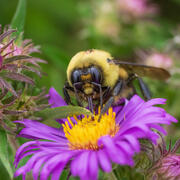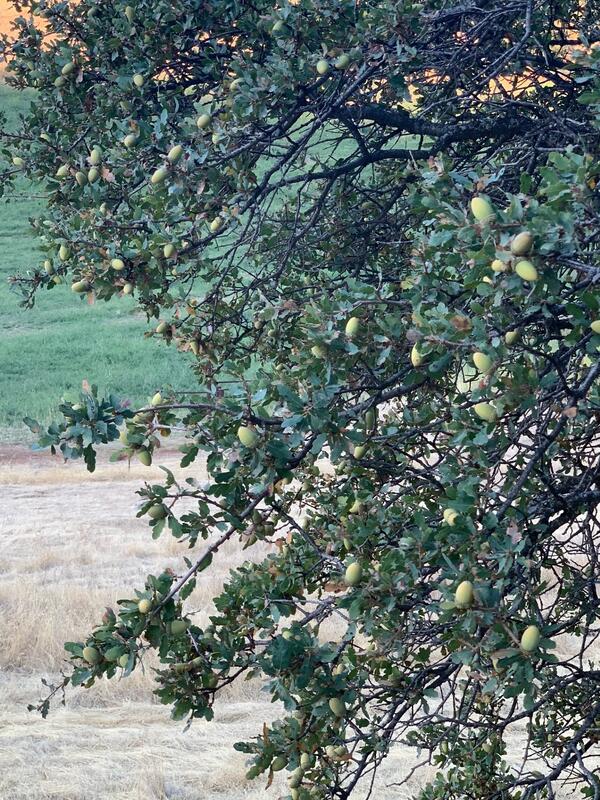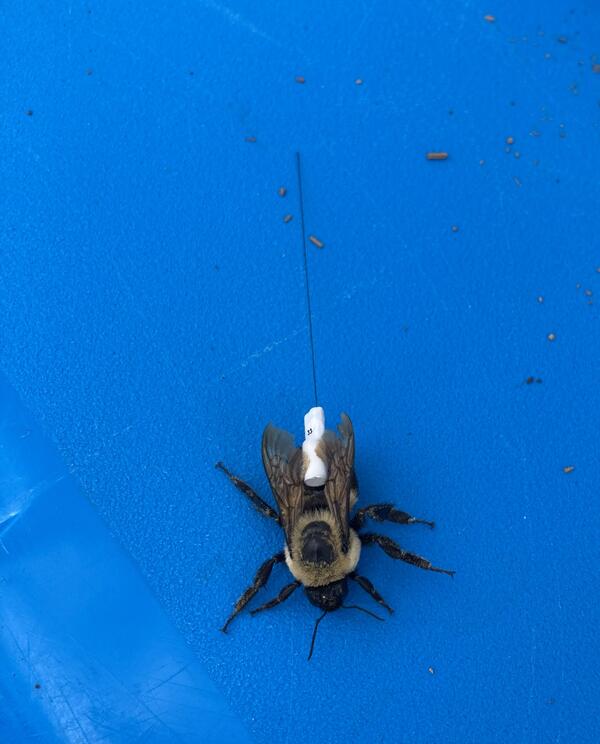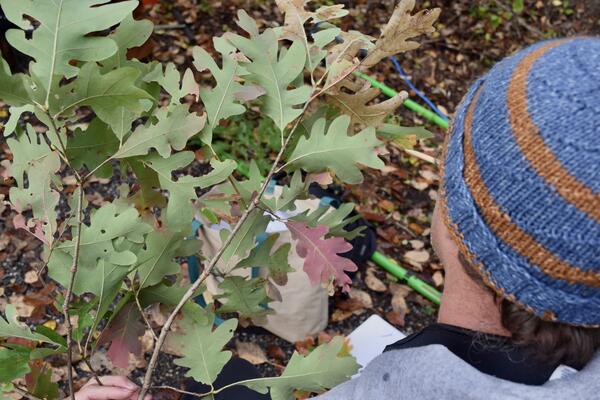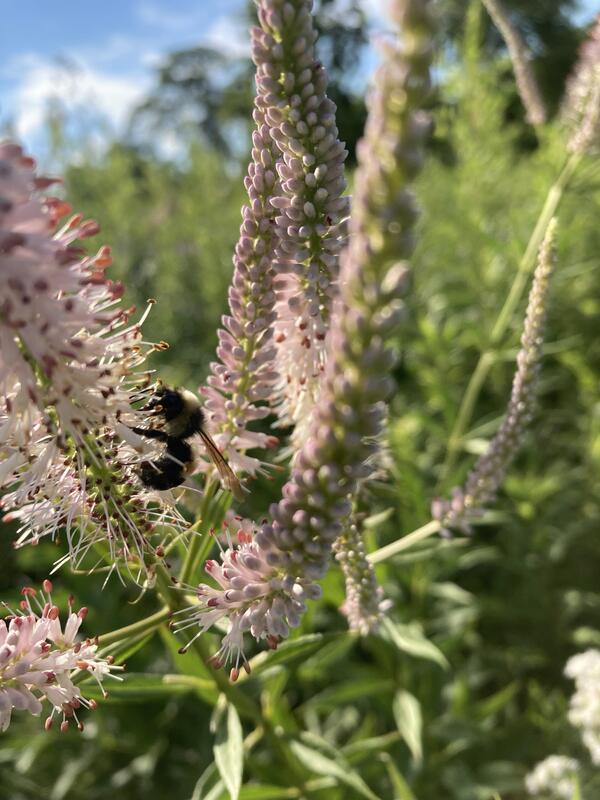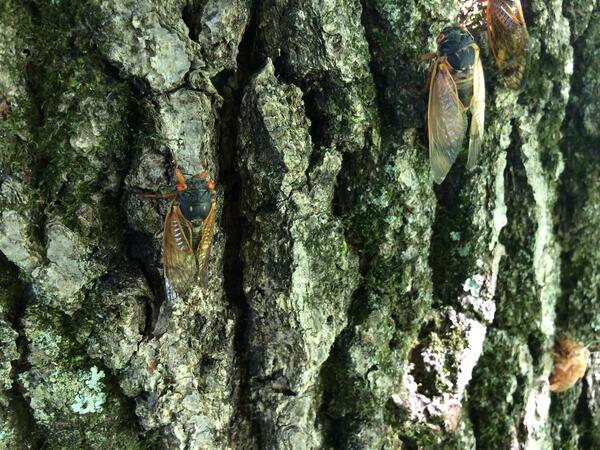Acorns covering a section of a blue oak tree. Photo by Ian Pearse (USGS, Fort Collins Science Center).
Ian Pearse, PhD
Ian is an ecologist who works on plants and insects.
Ian conducts research at the individual, population, community, and ecosystem level scales. His work focuses on plant-insect interactions and involves work on endangered insects such as bumble bees, strategies to map and control invasive plants, the chemical ecology and behaviors that affect herbivory, and the boom and bust seed production dynamics of many trees (i.e. mast seeding). His work informs management decisions made by the US Fish and Wildlife Service, National Parks, and a variety of other groups. Ian is especially fond of oak trees and spends a considerable amount of time staring up into them with the vague excuse of counting acorns, gall wasps, or rates of herbivory.
Professional Experience
2016 Postdoctoral work, University of California, Davis
2014-2015 Postdoctoral work, Illinois Natural History Survey
2012-2013 Postdoctoral work, Cornell University
Education and Certifications
PhD Entomology, University of California, Davis, 2011
BS Plant Biology, University of Illinois, Urbana-Champaign 2004
Affiliations and Memberships*
International Oak Society
Ecological Society of America
Entomological Society of America
Science and Products
Science for effective pollinator conservation and improved food security
Scaling-up phenological date matching for invasive species mapping: a free opensource workflow
INHABIT: A web tool for invasive plant management across the contiguous United States
Predicting risk of annual grass invasion following fire in sagebrush steppe and rangeland ecosystems
Predicting the phenology of invasive grasses under a changing climate to inform mapping and management
Developing a macroecological understanding of invasive plant impacts based on abundance and trait data
Data on Lepidium draba seed set and genetic diversity in northern Colorado Data on Lepidium draba seed set and genetic diversity in northern Colorado
Data to fit habitat suitability models at different invasion stages and their results to evaluate model decisions Data to fit habitat suitability models at different invasion stages and their results to evaluate model decisions
Community level traits of invaded plant communities in the United States Community level traits of invaded plant communities in the United States
INHABIT species potential distribution across the contiguous United States (ver. 4.0, June 2024) INHABIT species potential distribution across the contiguous United States (ver. 4.0, June 2024)
Projections of post-fire cover of non-native short-lived grasses and forbs under current and future climate conditions Projections of post-fire cover of non-native short-lived grasses and forbs under current and future climate conditions
Population genetic analysis of the rusty patched bumble bee in extant locations in 2022 Population genetic analysis of the rusty patched bumble bee in extant locations in 2022
Potential distribution of Japanese brome (Bromus japonicus) across the contiguous United States (October 2023) Potential distribution of Japanese brome (Bromus japonicus) across the contiguous United States (October 2023)
Management summary table for INHABIT species potential distribution across the contiguous United States: additional management units Management summary table for INHABIT species potential distribution across the contiguous United States: additional management units
Thresholded abundance models for three invasive plant species in the United States Thresholded abundance models for three invasive plant species in the United States
INHABIT species potential distribution across the contiguous United States (ver. 3.0, February 2023) INHABIT species potential distribution across the contiguous United States (ver. 3.0, February 2023)
Data on how Lepidium draba responds to damage of clones Data on how Lepidium draba responds to damage of clones
Data on grasshopper composition in the Thunder Basin National Grassland, Wyoming, USA Data on grasshopper composition in the Thunder Basin National Grassland, Wyoming, USA
Acorns covering a section of a blue oak tree. Photo by Ian Pearse (USGS, Fort Collins Science Center).
Researchers attach lightweight radio transmitters to bumble bees to track their movements and determine where they spend most of their time. Photo by Ian Pearse (USGS).
Researchers attach lightweight radio transmitters to bumble bees to track their movements and determine where they spend most of their time. Photo by Ian Pearse (USGS).
Hedgehog galls (Acraspis prinoides) on the underside of a chinquapin oak. Photo by Ian Pearse (USGS).
Hedgehog galls (Acraspis prinoides) on the underside of a chinquapin oak. Photo by Ian Pearse (USGS).
Oak flake gall wasp (Neuroterus quercusverrucarum) galls on the underside of an oak tree leaf. Photo by Ian Pearse (USGS)
Oak flake gall wasp (Neuroterus quercusverrucarum) galls on the underside of an oak tree leaf. Photo by Ian Pearse (USGS)
A bullet gall (Discholcaspis quercusmamma) on a bur oak stem. Photo by Ian Pearse (USGS).
A bullet gall (Discholcaspis quercusmamma) on a bur oak stem. Photo by Ian Pearse (USGS).
A researcher checks an oak tree branch for signs the tree might begin producing acorns.
A researcher checks an oak tree branch for signs the tree might begin producing acorns.
A rusty-patched bumble bee drinks nectar from a Culver's root flower. Photo by Ian Pearse (USGS).
A rusty-patched bumble bee drinks nectar from a Culver's root flower. Photo by Ian Pearse (USGS).
Cicadas cling to oak tree bark after emergence. Photo by Ian Pearse (USGS Fort Collins Science Center).
Cicadas cling to oak tree bark after emergence. Photo by Ian Pearse (USGS Fort Collins Science Center).
Why are non-native plants successful? Consistently fast economic traits and novel origin jointly explain abundance across US ecoregions Why are non-native plants successful? Consistently fast economic traits and novel origin jointly explain abundance across US ecoregions
U.S. Geological Survey Pollinator Science Strategy, 2025–35—A Review and Look Forward U.S. Geological Survey Pollinator Science Strategy, 2025–35—A Review and Look Forward
A quantitative classification of the geography of non-native flora in the United States A quantitative classification of the geography of non-native flora in the United States
Using plant invasions to compare occurrence- and abundance-based calculations of biotic homogenisation: Are results complementary or contradictory? Using plant invasions to compare occurrence- and abundance-based calculations of biotic homogenisation: Are results complementary or contradictory?
How to model a new invader? US-invaded range models outperform global or combined range models after 100 occurrences How to model a new invader? US-invaded range models outperform global or combined range models after 100 occurrences
First records distribution models to guide biosurveillance for non-native species First records distribution models to guide biosurveillance for non-native species
Predicted occurrence and abundance habitat suitability of invasive plants in the contiguous United States: Updates for the INHABIT web tool. Predicted occurrence and abundance habitat suitability of invasive plants in the contiguous United States: Updates for the INHABIT web tool.
Defining the pathobiomes associated with drippy blight in Colorado and drippy nut in California Defining the pathobiomes associated with drippy blight in Colorado and drippy nut in California
Phenology forecasting models for detection and management of invasive annual grasses Phenology forecasting models for detection and management of invasive annual grasses
The relationship between maturation size and maximum tree size from tropical to boreal climates The relationship between maturation size and maximum tree size from tropical to boreal climates
Predictor importance in habitat suitability models for invasive terrestrial plants Predictor importance in habitat suitability models for invasive terrestrial plants
Mast seeding in European beech (Fagus sylvatica L.) is associated with reduced fungal sporocarp production and community diversity Mast seeding in European beech (Fagus sylvatica L.) is associated with reduced fungal sporocarp production and community diversity
Non-USGS Publications**
http://onlinelibrary.wiley.com/doi/10.1111/nph.14114/full
http://onlinelibrary.wiley.com/doi/10.1111/1365-2745.12554/pdf
http://journals.plos.org/plosone/article?id=10.1371/journal.pone.0152537
http://onlinelibrary.wiley.com/doi/10.1890/14-0297.1/ful
http://onlinelibrary.wiley.com/doi/10.1890/15-0342.1/full
http://link.springer.com/article/10.1007/s10531-010-9956-0
http://www.pnas.org/content/106/43/18097.short
http://onlinelibrary.wiley.com/doi/10.1111/j.1365-3040.2005.01307.x/full
**Disclaimer: The views expressed in Non-USGS publications are those of the author and do not represent the views of the USGS, Department of the Interior, or the U.S. Government.
Science and Products
Science for effective pollinator conservation and improved food security
Scaling-up phenological date matching for invasive species mapping: a free opensource workflow
INHABIT: A web tool for invasive plant management across the contiguous United States
Predicting risk of annual grass invasion following fire in sagebrush steppe and rangeland ecosystems
Predicting the phenology of invasive grasses under a changing climate to inform mapping and management
Developing a macroecological understanding of invasive plant impacts based on abundance and trait data
Data on Lepidium draba seed set and genetic diversity in northern Colorado Data on Lepidium draba seed set and genetic diversity in northern Colorado
Data to fit habitat suitability models at different invasion stages and their results to evaluate model decisions Data to fit habitat suitability models at different invasion stages and their results to evaluate model decisions
Community level traits of invaded plant communities in the United States Community level traits of invaded plant communities in the United States
INHABIT species potential distribution across the contiguous United States (ver. 4.0, June 2024) INHABIT species potential distribution across the contiguous United States (ver. 4.0, June 2024)
Projections of post-fire cover of non-native short-lived grasses and forbs under current and future climate conditions Projections of post-fire cover of non-native short-lived grasses and forbs under current and future climate conditions
Population genetic analysis of the rusty patched bumble bee in extant locations in 2022 Population genetic analysis of the rusty patched bumble bee in extant locations in 2022
Potential distribution of Japanese brome (Bromus japonicus) across the contiguous United States (October 2023) Potential distribution of Japanese brome (Bromus japonicus) across the contiguous United States (October 2023)
Management summary table for INHABIT species potential distribution across the contiguous United States: additional management units Management summary table for INHABIT species potential distribution across the contiguous United States: additional management units
Thresholded abundance models for three invasive plant species in the United States Thresholded abundance models for three invasive plant species in the United States
INHABIT species potential distribution across the contiguous United States (ver. 3.0, February 2023) INHABIT species potential distribution across the contiguous United States (ver. 3.0, February 2023)
Data on how Lepidium draba responds to damage of clones Data on how Lepidium draba responds to damage of clones
Data on grasshopper composition in the Thunder Basin National Grassland, Wyoming, USA Data on grasshopper composition in the Thunder Basin National Grassland, Wyoming, USA
Acorns covering a section of a blue oak tree. Photo by Ian Pearse (USGS, Fort Collins Science Center).
Acorns covering a section of a blue oak tree. Photo by Ian Pearse (USGS, Fort Collins Science Center).
Researchers attach lightweight radio transmitters to bumble bees to track their movements and determine where they spend most of their time. Photo by Ian Pearse (USGS).
Researchers attach lightweight radio transmitters to bumble bees to track their movements and determine where they spend most of their time. Photo by Ian Pearse (USGS).
Hedgehog galls (Acraspis prinoides) on the underside of a chinquapin oak. Photo by Ian Pearse (USGS).
Hedgehog galls (Acraspis prinoides) on the underside of a chinquapin oak. Photo by Ian Pearse (USGS).
Oak flake gall wasp (Neuroterus quercusverrucarum) galls on the underside of an oak tree leaf. Photo by Ian Pearse (USGS)
Oak flake gall wasp (Neuroterus quercusverrucarum) galls on the underside of an oak tree leaf. Photo by Ian Pearse (USGS)
A bullet gall (Discholcaspis quercusmamma) on a bur oak stem. Photo by Ian Pearse (USGS).
A bullet gall (Discholcaspis quercusmamma) on a bur oak stem. Photo by Ian Pearse (USGS).
A researcher checks an oak tree branch for signs the tree might begin producing acorns.
A researcher checks an oak tree branch for signs the tree might begin producing acorns.
A rusty-patched bumble bee drinks nectar from a Culver's root flower. Photo by Ian Pearse (USGS).
A rusty-patched bumble bee drinks nectar from a Culver's root flower. Photo by Ian Pearse (USGS).
Cicadas cling to oak tree bark after emergence. Photo by Ian Pearse (USGS Fort Collins Science Center).
Cicadas cling to oak tree bark after emergence. Photo by Ian Pearse (USGS Fort Collins Science Center).
Why are non-native plants successful? Consistently fast economic traits and novel origin jointly explain abundance across US ecoregions Why are non-native plants successful? Consistently fast economic traits and novel origin jointly explain abundance across US ecoregions
U.S. Geological Survey Pollinator Science Strategy, 2025–35—A Review and Look Forward U.S. Geological Survey Pollinator Science Strategy, 2025–35—A Review and Look Forward
A quantitative classification of the geography of non-native flora in the United States A quantitative classification of the geography of non-native flora in the United States
Using plant invasions to compare occurrence- and abundance-based calculations of biotic homogenisation: Are results complementary or contradictory? Using plant invasions to compare occurrence- and abundance-based calculations of biotic homogenisation: Are results complementary or contradictory?
How to model a new invader? US-invaded range models outperform global or combined range models after 100 occurrences How to model a new invader? US-invaded range models outperform global or combined range models after 100 occurrences
First records distribution models to guide biosurveillance for non-native species First records distribution models to guide biosurveillance for non-native species
Predicted occurrence and abundance habitat suitability of invasive plants in the contiguous United States: Updates for the INHABIT web tool. Predicted occurrence and abundance habitat suitability of invasive plants in the contiguous United States: Updates for the INHABIT web tool.
Defining the pathobiomes associated with drippy blight in Colorado and drippy nut in California Defining the pathobiomes associated with drippy blight in Colorado and drippy nut in California
Phenology forecasting models for detection and management of invasive annual grasses Phenology forecasting models for detection and management of invasive annual grasses
The relationship between maturation size and maximum tree size from tropical to boreal climates The relationship between maturation size and maximum tree size from tropical to boreal climates
Predictor importance in habitat suitability models for invasive terrestrial plants Predictor importance in habitat suitability models for invasive terrestrial plants
Mast seeding in European beech (Fagus sylvatica L.) is associated with reduced fungal sporocarp production and community diversity Mast seeding in European beech (Fagus sylvatica L.) is associated with reduced fungal sporocarp production and community diversity
Non-USGS Publications**
http://onlinelibrary.wiley.com/doi/10.1111/nph.14114/full
http://onlinelibrary.wiley.com/doi/10.1111/1365-2745.12554/pdf
http://journals.plos.org/plosone/article?id=10.1371/journal.pone.0152537
http://onlinelibrary.wiley.com/doi/10.1890/14-0297.1/ful
http://onlinelibrary.wiley.com/doi/10.1890/15-0342.1/full
http://link.springer.com/article/10.1007/s10531-010-9956-0
http://www.pnas.org/content/106/43/18097.short
http://onlinelibrary.wiley.com/doi/10.1111/j.1365-3040.2005.01307.x/full
**Disclaimer: The views expressed in Non-USGS publications are those of the author and do not represent the views of the USGS, Department of the Interior, or the U.S. Government.
*Disclaimer: Listing outside positions with professional scientific organizations on this Staff Profile are for informational purposes only and do not constitute an endorsement of those professional scientific organizations or their activities by the USGS, Department of the Interior, or U.S. Government


